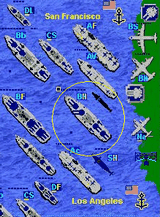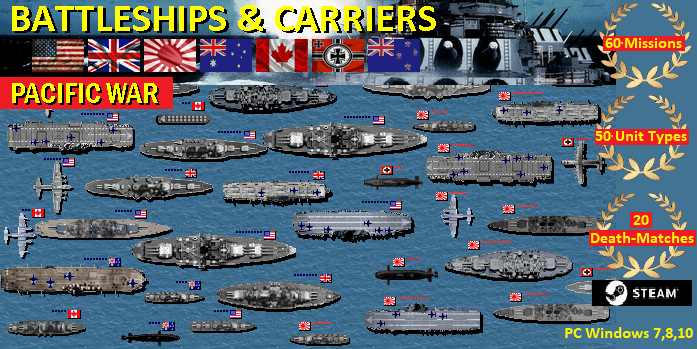Pacific War Battleship Game
BattleFleet 1939 Game
Battleship Pac.War
Battleship PC Game
Armada Battleship Game
General Battleship Game
Battleship Chess Game
SeaWar 2 - The Battleship Game
SeaWar - Battleship PC Game
Standard Battleship PC game
BATTLESHIP
GAME
World War 2 Edition
 |
Battleship Game
World War 2
( Size: 7.9 MB )

|
Battleship Game - WW2 Naval
Strategy: the best choice among aircraft carrier games
and submarine games.
Battleship game missions and scenarios:
Pearl Harbor Game
Atlantic Game 1943
Sink Cruisers Game
Midway Game
Iwo Jima Game
US Marines Game
Luftwaffe Game Pacific
Torpedo Game Boats
Bismarck Game Pacific
Destroy RAF Game
Okinawa
Us Navy Submarine Game
Fleet Submarines Game
Kamikaze Game
U Boat Game
Singapore Game
Swordfish Hunt
Patrol Boats
Air Supremacy
Alert
Battleships Game
Java
Defense
Fleet Cruisers Game
Atlantic Island
Coral Sea Game
Iron Sea
Mykonos
Imperial Ocean
Long Convoy
Skagerrak
Target Los Angeles
West Pacific Game
Pacific War Game
Leyte Transport
Emperor Hirohito
Normandy Game
South Pacific Game
Destroy USAF Game
Submarine Games
US Navy Game
Free Hunt Doenitz Game
Free Hunt Spruance Game
Free Hunt Halsey Game
Imperial Navy I
Royal Navy Game
Free Hunt Pearl Harbor Games
Midway II
Kriegsmarine I
Brisbane Convoy
Clear West Coast
Fall Of Australia
Battle For Leyte
Conquer Of Japan
HMAS Perth
Road To Okinawa
Orange Ports
Emperor Defense
Prince Of Wales
San Bernardino
Pacific Race
Heavy Duty
Tokio Express
Operation Sidney
Bomber Operation
Conquer Of Italy
Heavy Cruiser Game
Frigate Hunt
Santa Cruz
Lamansh Game
Azores Transport
Norway Convoy
Invasion
Grossadmiral
Norway Ports
Drang Nach Ost
Convoy Pk30
Ciano Defense
Sir John Tovey
Free Hunt Andrews
Germans On Pacific
Silent Hunt
Antigua
Return To Midway
Kriegsmarine Game II
Royal Air Force Game
F. Hunt Lancaster
Jamamoto Game
Free Hunt USN
Free Hunt Japan
Free Hunt RAAF
Free Hunt U Boat Game
Free Hunt Aircraft Carriers Game
Free Hunt Hawaii
Free Hunt Yamato Game
Free Hunt Iwo Jima Game
Free Hunt Pacific Game
Free Hunt Torpedos
Free Hunt Convoy
Free Hunt Germany
Free Hunt Germany II
Free Hunt Italy
Free Hunt Malaya
Free Hunt Subs Game
Free Hunt B-29 Game
Free Hunt USN 1944
Devil Island
Dragoon Carriers
|
Battleship
Musashi 1942-1944
Battleship Musashi, "sister" of the 65,000-ton
WW2 battleship Yamato, was built at Nagasaki, Japan.
Commissioned in August 1942, she was stationed at Truk
from January 1943 into 1944 as part of a heavy force
covering the Central Pacific against the threat of an
American offensive. When the latter materialized, with
the invasion of the Marshalls and raids by aircraft
carrier planes against Japanese positions further west,
Musashi's base was moved to the Palaus. She was torpedoed
by the submarine USS Tunny (SS-282) on 29 March 1944,
necessitating repairs in Japan, during which her
anti-aircraft firepower was enhanced.
In June 1944, with the torpedo
damage repaired, Musashi took part in the Battle of the
Philippine Sea. Her next, and last, major operation was
the Battle of Leyte Gulf, in which the Japanese surface
navy made a final major effort to repulse the U.S. drive
into the Western Pacific. On 24 October 1944, while en
route to the prospective battle area off the Leyte
landing beaches, Musashi and her consorts were attacked
by hundreds of U.S. Navy carrier aircraft. In this Battle
of the Sibuyan Sea, she was hit by some nineteen
torpedoes and seventeen bombs. Though her heavy
protection withstood this massive damage to a degree
probably unsurpassed by any other contemporary warship,
Musashi capsized and sank about four hours after she
received her last hit.
| Yamato Class Specifications |
Length
|
862 feet 6
inches |
| Beam |
127
feet 6 inches |
| Displacement |
72,809
tons |
| Screws + SHP |
4 screws,
150,000 SHP |
| Speed |
27 knots |
| Complement |
3000 |
Armament
typical
1943-44 |
Armament
(1941): 9 of 480 mm guns in 3 turrets; 12 of 155
mm guns; 12 of 12.7 mm guns; 24 of 25 mm AA guns;
8 of 13 mm AA guns. By 1945 the 155 mm and 13 mm
guns had been removed and the AA defences had
been boosted to 146 of 25 mm guns. |
| Aircraft |
Six |
| CIA / KGB intelligence
game. Run your own operation
game. Travel around the world and set up
espionage game, trade with state secrets, weapon
systems, spy codes, WMD, hire secretaries,
agents, lawyers and soldiers, establish secret
agent stations, cells and bases and search for
criminals and politicians. Involve in agent game.
Game contains more than 40 missions including
Nuclear Game, Cold War Game, Secret Agent, CIA
Games, USAF, Prime Minister, RAF, Bin Laden,
Sadam, KGB, Operations Iran… |
|
Battleship Musashi Design
and Construction
Musashi was the second ship of the Yamato class
heavy-battleships, designed by the Imperial Japanese Navy
in 1937. Musashi and her sister-ships were built to be
capable of engaging several opposing capital-ships
simultaneously, as a method of compensating for Japan's
inability to industrially match the United States Navy.
With each vessel of the Yamato class displacing well over
70,000 tons, it was hoped that the firepower of Musashi
and her sister-ships could offset American industrial
power.
The keel of Musashi was laid down 29 March 1938 at
Mitsubishi's Nagasaki shipyard, and was designated
"Battleship No. 2". Throughout construction,
large hanging blinds made of hemp rope and strategically
placed warehouses prevented outsiders from viewing
construction. The deceptions were so successful that the
American Consulate—located across the bay from
Musashi's construction site—was unaware of her
existence during her construction.[3] Because of the
vessel's size, the Nagasaki dockyards and construction
equipment had to be heavily modified to fit Musashi's
hull. Musashi was launched 1 November 1940, with Captain
(later Vice Admiral) Kaoru Arima assigned as her Chief
Equipping Officer.
Battleship Musashi Armament
Musashi's main battery consisted of nine 18.1 inch 40
cm/45 Type 94 naval guns—the largest caliber of
naval artillery ever fitted to a warship. Each gun was
21.13 metres (69.3 ft) long, weighed 147.3 metric tons
(162.4 short tons), and was capable of firing
high-explosive or armour-piercing shells 42.0 kilometres
(26.1 mi).
Musashi's secondary battery comprised twelve 6.1-inch (15
cm) guns mounted in four triple turrets (one forward, one
aft, two midships), and twelve 5-inch (13 cm) guns in six
double-turrets (three on each side amidships). In
addition, Musashi carried twenty-four 1-inch (2.5 cm)
anti-aircraft guns, primarily mounted amidships. When
refitted in 1944, the secondary battery configuration was
changed to six 6.1-inch (15 cm) guns, twenty-four 5-inch
(13 cm) guns, and one hundred-thirty 1-inch (2.5 cm)
antiaircraft guns, in preparation for naval engagements
in the South Pacific.
Battleship Musashi Deployment and Combat
Battleship Musashi - 1942: Commissioning and Sea
Trials
On 5 August 1942, Musashi was commissioned at Nagasaki,
with Arima Kaoru assigned as Captain; she joined Yamato,
Nagato and Mutsu in the 1st Battleship Division the same
day.[4] From 3–28 September 1942, Musashi was fitted
out with her secondary armament, consisting of twelve
127-mm guns, thirty-six 25-mm guns and four 13.2-mm light
machine guns, as well as additional radar equipment.[4]
Throughout October and November, Musashi carried out
trials and gunnery-drills near Kure. In December 1942,
following aircraft drills with Zuikaku, Musashi was
declared operational.
Battleship Musashi - 1943: Flagship of the
Combined Fleet
On 18 January 1943, Musashi departed Kure for Truk
Lagoon, arriving four days later. On 11 February 1943,
Musashi replaced her sister-ship Yamato as flagship of
the Japanese Combined Fleet under Admiral Isoroku
Yamamoto.[4] On 1 April 1943, Yamamoto departed Musashi
and flew to Rabaul, New Britain, to personally direct
Operation I-Go, a Japanese air offensive in the Solomon
Islands.[12] Fifteen days later, acting on codes
deciphered by Ultra, Yamamoto was killed when his
aircraft was shot down by American fighter aircraft while
he was en-route from New Britain to Ballale,
Bougainville.[12] On 23 April 1943, Yamamoto's cremated
remains were taken to Truk and placed in his cabin
on-board Musashi where other Combined Fleet officers
visited and paid their respects.[12]
Emperor Hirohito and his Command Staff on board Musashi
on 24 June 1943
On 17 May 1943, in response to American attacks on Attu
Island, Musashi, along with two light carriers, nine
destroyers, and two cruisers, was deployed to the
northern Pacific.[4] When no contact was made with
American forces, Musashi traveled to Japan and delivered
Yamamoto's ashes to Kure on May 23. The ashes were taken
from the vessel in preparation for a formal, state
funeral[13] Immediately afterwards, Musashi joined a
significantly larger force to counterattack American
naval forces off of Attu. However, when Attu fell before
the force could be fully deployed, the counterattack was
abandoned and Musashi returned to Japan.
On 24 June, while undergoing overhauling and repairs at
Yokosuka, Musashi was visited by Emperor Hirohito and
other high-ranking naval officials.[4] Transferring to
Kure on 1 July 1943, Musashi drydocked the same day. From
1–8 July, Musashi was upgraded with improved firing
control and radar. Following several transfers between
the Home Islands bases, Musashi deployed to Truk on 31
July, arriving six days later.
On 18 September 1943, Musashi sortied from Truk alongside
three other battleships in response to American raids on
Eniwetok and Brown Island. Seven days later, the fleet
returned to Truk without having contacted the American
forces. In October, in response to suspicions of planned
American raids on Wake Island, Musashi led a large fleet
under Admiral Mineichi Koga—three fast carriers, six
battleships and eleven cruisers—to intercept
American carrier forces. When no contact was made, the
fleet returned to Truk on 26 October 1943.[4] The
remainder of 1943 was spent in Truk Lagoon; as her
previous captain was promoted, Captain Asakura Bunji
assumed command of Musashi on 7 December 1943.
Battleship Musashi - 1944: Combat and Loss
Musashi remained in Truk Lagoon until 10 February 1944,
when she returned to Yokosuka alongside three smaller
vessels. On 24 February, Musashi departed Yokosuka with
two specialized army battalions and their munitions for
Palau. The same day as she departed Japan, Musashi's
battlegroup encountered a typhoon, during which the
majority of the battleship's deck cargo was lost.[4]
Musashi arrived at Palau on 29 February 1944, and
remained at the base for the next month. On 29 March
1944, in anticipation of American air-raids on the
island, Musashi departed Palau under the cover of
darkness.[4] Almost immediately after leaving Palau,
Musashi and her escorts were attacked by the American
submarine Tunny, which fired six torpedoes at the
battleship.[15] However, Musashi's escorts spotted the
torpedo-wakes, and the battleship was able to evade five
of the six torpedoes. One struck near the bow, flooding
the hydrophone compartment and causing 18 casualties.
Musashi as she appeared in 1944
On 3 April, Musashi arrived at Kure for repairs. From
10–22 April 1944, Musashi underwent repairs and
upgrades, receiving new radar, depth-charge rails, and
increased antiaircraft capabilities. When she undocked on
22 April, Musashi's secondary battery was composed of six
6.1-inch guns, 12 5-inch guns, one hundred-thirty 25-mm
guns, and four 13-mm machine-guns.
In May 1944, Musashi departed Kure for Okinawa, then
Tawitawi alongside the Japanese Second Fleet—under
the command of Vice-Admiral Jisaburo Ozawa. On 10 June
1944, Musashi departed Tawitawi for Biak, with the
intention of counter-attacking the American invasion of
the island.] Two days later, when word reached Ozawa of
American attacks on Saipan, the Second Fleet diverted
from Biak to the Mariana Islands. During the Battle of
the Philippine Sea, Musashi escorted fast carriers of the
Japanese Second Fleet. Following Japan's disastrous
defeat in the battle—during which some 450 aircraft
and two fast carriers were lost—the Second Fleet
returned to Japan. On 10 July 1944, Musashi departed
Okinawa for Singapore, alongside her sister-ship Yamato.
Musashi under attack by American carrier aircraft during
the Battle of Leyte Gulf
On 18 October 1944, Musashi joined the main Japanese
fleet in Brunei, in preparation for Operation Sho-1, the
counterattack planned against the American landings at
Leyte. The Japanese plan called for Ozawa's carrier
forces to lure the American carrier fleets north of Leyte
so that the Central Force, under the command of
Vice-Admiral Takeo Kurita, could enter Leyte Gulf and
destroy American forces landing on the island. With this
objective, five battleships, including Musashi, and ten
heavy cruisers departed Brunei for the Philippines on 20
October.
Soon after departing Brunei, two American submarines
torpedoed and sank two of Kurita's heavy-cruisers,
including Kurita's flagship Atago; forcing Kurita to
transfer his flag to Yamato. On 24 October 1944, Kurita's
centre force came under heavy air-attack while transiting
the Sibuyan Sea by five separate strikes of American
carrier task forces. Early in the assaults, American
carrier pilots—primarily from the Essex, Franklin
and Intrepid—learned to capitalize on Musashi's
armour deficiencies near the bow, heavily damaging the
battleship in the first three raids, and forcing her to
slow to 10 knots. When it became apparent that the ship
could not sustain further damage, her captain, Rear
Admiral Inoguchi, attempted to run her aground on a
nearby island. Musashi sank at 19:36, however, having
been overwhelmed by seventeen bomb and nineteen torpedoes
hits. 1,023 of her 2,399-man crew died, with the
remainder being rescued by Japanese destroyers several
hours later. Eighteen American aircraft were lost in the
attack.
|
The Yamato class battleships were
battleships of the Imperial Japanese Navy (IJN)
constructed and operated during World War II. Displacing
72000 long tons (73000 t) at full-load, the vessels of
the class were the largest, heaviest, and most
heavily-armed battleships ever constructed. The class
carried the largest naval artillery ever fitted to a
warship, 460-millimetre (18.1 in) naval guns, each of
which was capable of firing 2,998-pound (1,360 kg) shells
over 26 miles (42 km). Two battleships of the class
(Yamato and Musashi) were completed, while a
third—the Japanese aircraft carrier Shinano—was
converted to an aircraft carrier during construction. Due to the threat of American
submarines and aircraft carriers, both Yamato and Musashi
spent the majority of their careers in naval bases at
Brunei, Truk, and Kure, before participating in the
Battle of Leyte Gulf, as part of Admiral Kurita's Centre
Force. Musashi was sunk during the course of the battle
by American carrier airplanes. Shinano was sunk ten days
after her commissioning in November 1944 by the submarine
USS Archer-Fish, while Yamato was sunk in April 1945
during Operation Ten-Go.
| |
 Size:7.6Mb Size:7.6Mb |
 |
| Turn-based WW2
naval game, extension to the classic
Submarine game (Battleship game) where
ships/planes/subs can move. Contains plenty of
game missions, game campaigns and 40 ship,
submarine, airplane ana port artillery types,
with combat maps up to 96X96 large. |
| |
| |
| |
| |
| |
| |
 |
Turn-based space
strategy game represents World War 4
conflict on tactical level.
The user-friendly game engine allows more than 60
unit types, including planet battleships, galaxy
cruisers, death-stars, stealth units, star
destroyers, air-space interceptors, explorers,
planet artillery and radars. |
| |
| |
 |
| Tycoon Strategy
Game - build your own world business empire as an
arms dealer tycoon. Travel around the world,
trade with more than 400 weapon systems, hire
secretaries, bodyguards, lawyers, fighters and
tanks, establish companies and search for
criminals and hostages. |
| |
|
